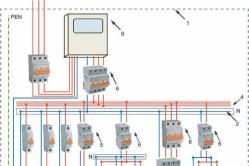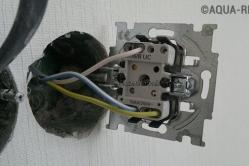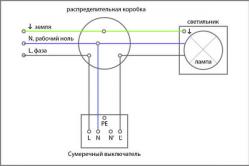Antipyretics for children are prescribed by a pediatrician. But there are emergency situations for fever when the child needs to be given medicine immediately. Then the parents take responsibility and use antipyretic drugs. What is allowed to give to infants? How can you bring down the temperature in older children? What medicines are the safest?
The article raises the issue of using various devices to identify communications hidden in the wall, such as electrical wiring, water pipes, plasterboard frame elements, reinforcement of concrete blocks, voids, wooden elements.
Sometimes it is extremely necessary to find out where hidden electrical wiring goes, find the places where hidden water pipes, metal frames, cavities in concrete, steel reinforcement and many other “surprises” hidden under a layer of plaster pass.
Electric shock is the most dangerous thing that can happen to a worker, so let's start the analysis with highly specialized devices that minimize this hazard.
Detection of electrical wiring with an indicator screwdriver
The minimum tool that any home owner should have is a hidden wiring indicator. This is the simplest and cheapest tool, based on the principle of capturing the electromagnetic field emitted by electrical wiring.
 Indicator screwdriver with the function of detecting hidden wiring
Indicator screwdriver with the function of detecting hidden wiring
This device, like similar ones, has three degrees of sensitivity:
- "O" - the definition of the phase in the supply network.
- "L" - non-contact detection of the presence of electrical wiring with low sensitivity.
- "H" - non-contact detection of the presence of electrical wiring with increased sensitivity.
 Screwdriver indicator operating mode switch
Screwdriver indicator operating mode switch
The quality of determining the presence of wiring in this device is fully consistent with its cost. It is possible to determine that wiring is hidden in the wall, but at the same time, even at minimum sensitivity, it will show a zone prohibited for work with a width of 10-20 cm (indication is performed by a green LED with an additional sound signal, its intensity will be maximum in the place of direct, according to the electrical circuit indicator, approaching the wiring).
A small useful bonus of this indicator is the ability to use it to check the integrity of the circuit. The device uses the human body as a “wire”, for this we put a finger on the upper contact panel, with the other hand we take one end of the conductive part of the wire, and bring the “nose” of the indicator to the second bare point of the wire. If the circuit is not broken, then in the "O" mode, the red indication lamp will light up, but the accuracy of detecting a break leaves much to be desired. The instrument cannot find shielded or dead wires.
 Additional contact for "dialing"
Additional contact for "dialing"
The indicator is powered by two batteries hidden in the handle next to the tweeter.
 Indicator Power
Indicator Power
It is important to store the indicator in the “O” state and with the cap of the screwdriver bit closed, as the batteries run out very quickly in the indication mode.
Semi-professional equipment for detecting electrical wiring
Semi-professional detectors are next in class and quality of electrical wiring detection.
These devices are mostly universal and can determine the composition of the wall in front of them, find cavities in it, live electrical wiring, non-ferrous and ferrous metals. The principle of operation of these devices is based on the generation of a magnetic field and capturing its changes when passing through various media (steel, cast iron, iron - enhance the electromagnetic field, aluminum and copper - reduce, the magnetic permeability of solid concrete is higher than that of hollow concrete, etc. ). These devices, analyzing the results obtained, can quite accurately determine what is in front of them.
The main advantage over the indicator screwdriver is a higher accuracy in detecting objects, thanks to the auto-calibration of the sensing element. At the same time, the ability to find reinforcing reinforcement and cavities in the wall makes it possible to avoid breakdown of water pipes and damage to drills when they hit a steel surface.
We strongly recommend that, in order to identify the features of the operation of each device, before using it directly, test them on a wall in which the position of electrical wiring, metal, wood and other inclusions is already known.
Detector Black&Decker BDS300

A fairly simple model, the indication in which is completely made on LEDs. A hard mode switch allows you to quickly reconfigure the device to search for metal or wood. When the device is “confident” in detecting the desired element, an audible signal is emitted. Indication of the presence of electrical wiring is placed on a separate LED, and a convenient button for forced calibration of the sensor allows you to change the sensitivity and reduce the error in detecting an object to a minimum. The device scans only in one direction, in order to accurately determine the location of a structural element, it is necessary to turn the device ninety degrees and repeat the scan.
Metal detector Zircon TriScanner PRO SL

The device has three basic functions:
- Detection of metal structures.
- Detection of timber frames.
- Deep scan.
When an object is confidently detected, the LED highlighting the conditional direction turns on, while the object itself is located exactly under the crosshair highlighted on the body. The detection of live electrical wiring is performed continuously, regardless of the selected scan mode.
Universal detector Skil 0550 AA

An advanced model with a built-in LCD display. The device can search for wood, various types of metals, while detecting live electrical wiring, it gives out an audible warning signal, duplicated by a red LED. For a more accurate location of the found object, use the Focus button. The location can be marked through a through hole in the center of the detecting circuit.
Digital detector Bosch PDO Multi

A budget model that has all the features of more expensive Bosch devices. Quite accurately determines the various materials inside the walls, identifies the presence of electrical wiring under potential. The location of the expected location of the found elements or refined using the Zoom function can be marked through the sensor target.
Summary table of the capabilities of the devices in question:
| Sensor | Screwdriver indicator | ||||
| Discoverable elements | live wires | Live wires, ferrous metals, non-ferrous metal, wood | Live wires, ferrous metals, non-ferrous metal, wood | Live wires, ferrous metals, non-ferrous metal, wood | |
| The ability to determine the depth of the object | No | Yes | No | Yes | No |
| Declared metal detection depth | No | 50 mm | 38 mm | 60 mm | 60 mm |
| Claimed detection depth for non-ferrous metals | No | 50 mm | 76 mm | 80 mm | 80 mm |
| Claimed Wood Detection Depth | No | 19 mm | 19 mm | 20 mm | 20 mm |
| price, rub. | 150 | 1250 | 1950 | 2400 | 4000 |
The use of universal measuring instruments that scan the internal structure of the wall makes it possible to minimize the possibility of accidental electric shock, keep the instrument intact, and easily rebuild the room. The only drawback of all the considered devices is their versatility. They easily cope with the search for elements in a homogeneous structure, but they can give erroneous information at the junction of more than two dissimilar objects. It is necessary to “adapt” to the operation of each of the scanners in order to correctly interpret the signals generated by the device.
Vlad Taranenko, rmnt.ru



